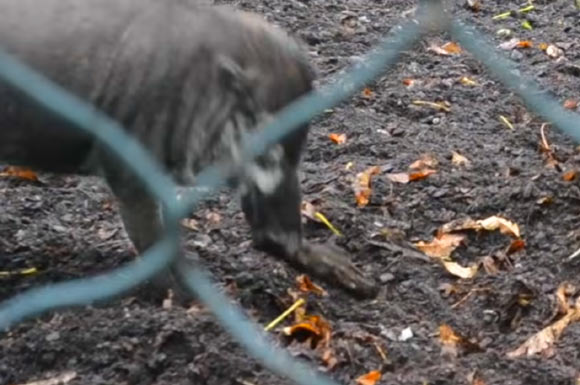Scientists have uncovered the first evidence of tool use by the Visayan warty pig (Sus cebifrons), a critically endangered species native to the Philippines.

An adult female Visayan warty pig uses a piece of bark as a digging tool. Image credit: Root-Bernstein et al, doi: 10.1016/j.mambio.2019.08.003.
The Visayan warty pig, a species that inhabits dense forests in the Visayan chain of islands in the Philippines, is the first tool-user in the pig family Suidae.
“Observations of unprompted tool use represented for the first time in a phylogenetic family are rare,” said Dr. Meredith Root-Bernstein from the Université Paris-Saclay in France and the Institute of Ecology and Biodiversity in Chile and her colleagues.
“These open new possibilities for research on tool use and social learning in Suidae.”
The researchers monitored a group of four Visayan warty pigs (three females and a male) living at the Ménagerie of the Jardin des Plantes in Paris, France.
They found that the captive animals used bark or sticks to dig and build nests.
“Very little is known about the behavior or ecology of Visayan warty pigs in the wild, including whether tool use is a naturally-occurring behavior in this species,” the scientists said.
The team observed three individuals using bark or sticks to dig with.
Two individuals (adult females) used the sticks or bark, using a rowing motion, during the final stage of nest building.
The third individual (an adult male) attempted to use a stick to dig with. Stick and branch manipulation was observed in other contexts, but not for digging.
“We argue that the observed use of bark, sticks and spatulas for digging fits the definition of tool use,” the authors said.
“It involved the manipulation of an external object (bark, stick, or spatula), it occurred exclusively and regularly within a goal-oriented repeated action pattern (digging a nest pit), and as its end result it altered both the distribution of the soil (to make a pit) and the physical properties of the tool user (a physical disposition, digging action).”
The researchers said they don’t know for sure who started using tools at the Ménagerie.
“However, we can assume that the transmission of the behavior was either vertical, from mother to daughter, or horizontal, between adult females and to the adult male,” they said.
A paper detailing the findings was published in the September 2019 issue of the journal Mammalian Biology.
_____
Meredith Root-Bernstein et al. 2019. Context-specific tool use by Sus cebifrons. Mammalian Biology 98: 102-110; doi: 10.1016/j.mambio.2019.08.003







